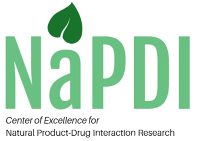Selection of green tea as a high-priority natural product
A comprehensive literature search conducted by the Pharmacology Core, combined with compelling preliminary in vitro data, identified intestinal UDP-glucuronosyltransferases (UGTs) as a high priority target for green tea-precipitated NPDIs. These effects have been attributed to polyphenols known as catechins, which constitute 30-42% of solid green tea extract by weight. As such, the catechins represent the most important and extensively studied green tea constituents in terms of potential precipitants of drug metabolizing enzyme- and transporter-mediated interactions with drugs.
Sourcing appropriate green tea products
The Analytical Core used metabolomics and biochemometrics approaches to prioritize candidate green tea products to study as precipitants of an intestinal UGT-mediated NPDI in human subjects. A single tea product was selected from 34 commercially available green tea samples based on the combination of metabolomics and chemometric data within the context of practical considerations including available single lot quantities, shelf-life, and sales. The selected green tea product underwent further quality assurance including key constituent quantification at least in triplicate to ensure reproducibility. A methanolic extract and selected fractions of this product were tested as inhibitors of intestinal UGT activity to confirm bioactivity.
Mechanistic in vitro evaluation
The green tea extract and fractions were prepared by the Analytical Core and provided to the Pharmacology Core for initial high throughput testing using human intestinal microsomes and a fluorescent UGT probe substrate. Raloxifene, an established in vitro and in vivo UGT1A object drug, was selected to complete detailed evaluation of the intestinal UGT inhibitory effects of green tea. The inhibitory potency (Ki) green tea product extract (provided by the Analytical Core), (-)-epicatechin gallate, and (-)-epigallocatechin gallate was determined using human intestinal microsomes. The induction potential of the clinical green tea product extract towards major drug metabolizing enzymes and transporters was also determined using sandwich-cultured human hepatocytes. The recovered inhibition and induction kinetics of green tea extracts/constituents provided the necessary mechanistic information to design a clinical green tea-raloxifene interaction study.
Clinical study design
Sixteen healthy adults (8 males, 8 females) participated in a crossover, open-label, three-arm, fixed-sequence study. The three arms included baseline (no green tea), short-term (acute) green tea administration, and long-term (chronic) green tea administration. Each arm consisted of one 12-hour inpatient visit and four 1-hour outpatient visits. Arm 1 involved administration of a single raloxifene dose (60 mg PO) to obtain baseline raloxifene pharmacokinetics. Arm 2 involved administration of a single raloxifene dose (60 mg PO) with brewed green tea (3 cups consumed within the first 6 hours) to determine the effects of acute green tea administration on raloxifene pharmacokinetics. Arm 3 involved administration of a single raloxifene dose (60 mg PO) following a 5-day pre-treatment with green tea (3 cups consumed within the 8-hour work day) to determine the effects of chronic green tea administration on raloxifene pharmacokinetics. Each arm was separated by at least one week to ensure sufficient washout of raloxifene (half-life ~28 hours), raloxifene 4’- and 6-glucuronides (half-lives <20 hours), and green tea catechins (half-lives <2 hours).
Data reporting
Literature data describing green tea metabolism and disposition and comprehensive data generated by the NaPDI Center interaction project to describe the green tea-raloxifene interaction have been uploaded into the database using standard operating procedures developed by the Informatics Core.
